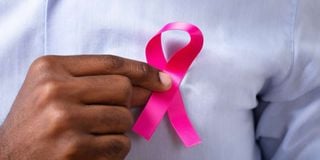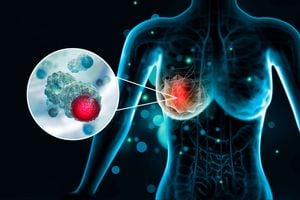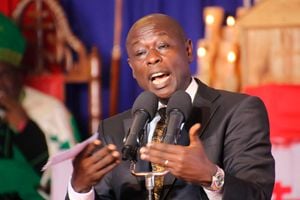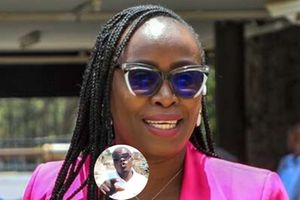What breast cancer risk means to you

A man's hand holding a pink ribbon supporting breast cancer awareness..
What you need to know:
- Globally, in 2018, it was estimated that there were 18.1 million new cancer cases diagnosed, with lung cancer being the leading closely followed by breast cancer, both accounting for 11.6 per cent of total cancer cases each
- . In 2020, in Kenya, of the estimated 42,000 new cancer patients diagnosed, 16 per cent of them were suffering from breast cancer.
- The importance of the Breast Cancer Awareness Month cannot be over-emphasised.
It is October and we are all out decked in pink. It is that time of year when we step it three notches up on the advocacy front with regard to breast cancer. The whole month is focused on creating awareness about the leading cancer in women across the world; encouraging screening and early treatment; and celebrating those who have been victorious in the fight.
Globally, in 2018, it was estimated that there were 18.1 million new cancer cases diagnosed, with lung cancer being the leading closely followed by breast cancer, both accounting for 11.6 per cent of total cancer cases each. In 2020, in Kenya, of the estimated 42,000 new cancer patients diagnosed, 16 per cent of them were suffering from breast cancer.
The importance of the Breast Cancer Awareness Month cannot be over-emphasised.
An online search on the advent of this highly significant campaign revealed a steadfast commitment to breast cancer awareness. The Britannica reveals that this campaign is attributed to a partnership between the American Cancer Society and the pharmaceutical division of Imperial Chemical Industries, now part of AstraZeneca. The partnership featured Betty Ford; a breast cancer survivor diagnosed when her husband, Gerald Ford, was in office as the president of the United States — as the campaign champion. She kick-started the week-long event, drawing massive attention to breast cancer.
The Brevard Health Alliance and a publication by Sally M Fernandez of the Breast Cancer Action website note that it took another seven years to introduce the pink ribbon as a symbol of the campaign. The original colour was actually peach, initiated by Charlotte Haley, who created handmade peach-coloured loops to honour her mother, her sister and her grandmother; who had each battled breast cancer. She would distribute sets of five ribbons with a card stating: “The National Cancer Institute annual budget is $1.8 billion, only five per cent goes to cancer prevention. Help us wake up our legislators and America by wearing this ribbon”
Meanwhile, Self Magazine had started publishing an annual Breast Cancer Awareness Month issue from 1991. The first edition was a sterling success, thanks to the guest editing by Evelyn Lauder, the senior corporate vice-president and a breast cancer survivor herself! The following year, Self Editor-in-Chief Alexandra Penney was looking to sustain the momentum set in the virgin edition. She thought of the ribbon idea and Estee Lauder promised to distribute the ribbons nationwide.
Haley caught the attention of Alexandra Penney and she offered national support. Haley turned it down. She felt that the partnership was too commercial and she wanted to stick to a grassroots approach. Self and Estée Lauder then went on to put out the pink ribbon, garnering support from multiple organisations and being entrenched as the colour of breast cancer awareness.
With al the attention drawn to breast cancer, what exactly does it mean to a person when we talk about risk factors?
Breast cancer occurs when there is molecular alteration at the cell level in the breast, resulting from DNA damage or inherited DNA defects or pro-cancerous genes like BRCA1 and BRCA2; that lead to breast epithelial cells acquiring immortal features and uncontrolled growth.
Simply put, the normal cells are transformed into abnormal cells that do not undergo a normal lifespan and also develop the ability to multiply extremely rapidly, resulting in development of tumours. These alterations vary in nature, resulting in tumour types that are variable. Some are responsive to oestrogen (ER), others to progesterone (PR) and others to human epidermal growth factor receptor 2 (HER2).
The tumour variety not only helps guide treatment but also helps address prevention. It basically lets us know that in the care of breast cancer, there is no one size fits all. When addressing risk factors, it is important to know that these increase the risk of the damaged PR abnormal DNA progressing to full-blown breast cancer or not. Risk factors are not a guarantee that one will get the disease. Some people may get breast cancer even with no discernible risk factor. Others may have all the risk factors and still not get sick. This is critical for patients, especially when they blame themselves for getting sick.
Several risk factors are not modifiable. One cannot be able to do anything about these risk factors. These include age; where women above 50 years are more likely to get breast cancer than those who are younger; those who inherit the genetic mutations such as BRCA1 and BRCA2; those who start menses earlier, before 12 years, and those who get late menopause, beyond age 55, due to the prolonged exposure to the reproductive hormones, oestrogen and progesterone; Those with dense breasts; those who have survived breast cancer in the past; those who have undergone previous treatment using radiation therapy; and women who were exposed to the drug diethylstilbestrol (DES), while in their mother’s womb.
The most important risk factor for breast cancer development is a family history of breast or ovarian cancer. The risk of breast cancer doubles if the family member is a first degree relative (a mother, sister, or daughter); and triples if it is more than one first degree relative. The risk is also quite significant (20 per cent to 30 per cent), when the relative is a second-degree relative (family members on either her mother’s or father’s side of the family). Having a first-degree male relative with breast cancer also raises a woman’s risk.
Race is also an important factor to note. White, Caucasian women appear to have the highest risk of breast cancer, at 128 per 100,000, closely followed by black women at 124 per 100,000. Latina and Asian women rank lowest at about 91 per 100,000. Further, black women appear more likely to develop breast cancer below the age of 50.
These are risk factors that one cannot change. They are literally born with this inherent risk.
For the modifiable risks, then the person is able to put in place interventions that reduce the risk. The care providers must put emphasis here. The presence of modifiable risks increases the chances of breast cancer in a person with inherent risks, much worse than the person without such risk factors.
Modifiable risks include sedentary lifestyle with lack of physically activity; obesity, especially in menopause; oestrogen and progesterone hormone use, either as contraceptives or as hormone replacement therapy in menopause, delayed childbearing beyond age 30; not being able to carry a pregnancy to term; not breastfeeding and excessive alcohol consumption. Other suggested possible risks include nicotine, oncogenic chemical exposure and disruption of normal cyclic patterns of other non-reproductive hormones due to situations such as night shift work.
This conversation must be held in context to empower women and men, to appreciate the need for screening, early detection and treatment, since we may not have too much that we can modify, by way of preventing breast cancer!
Dr Bosire is an obstetrician/ gynaecologist





